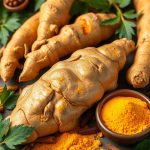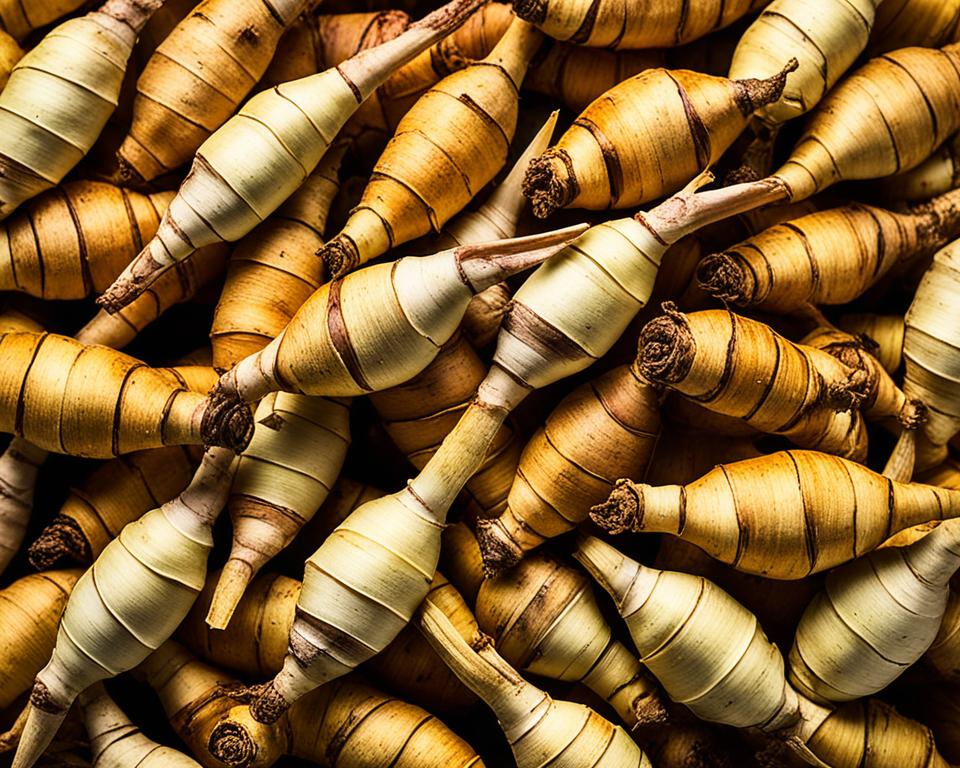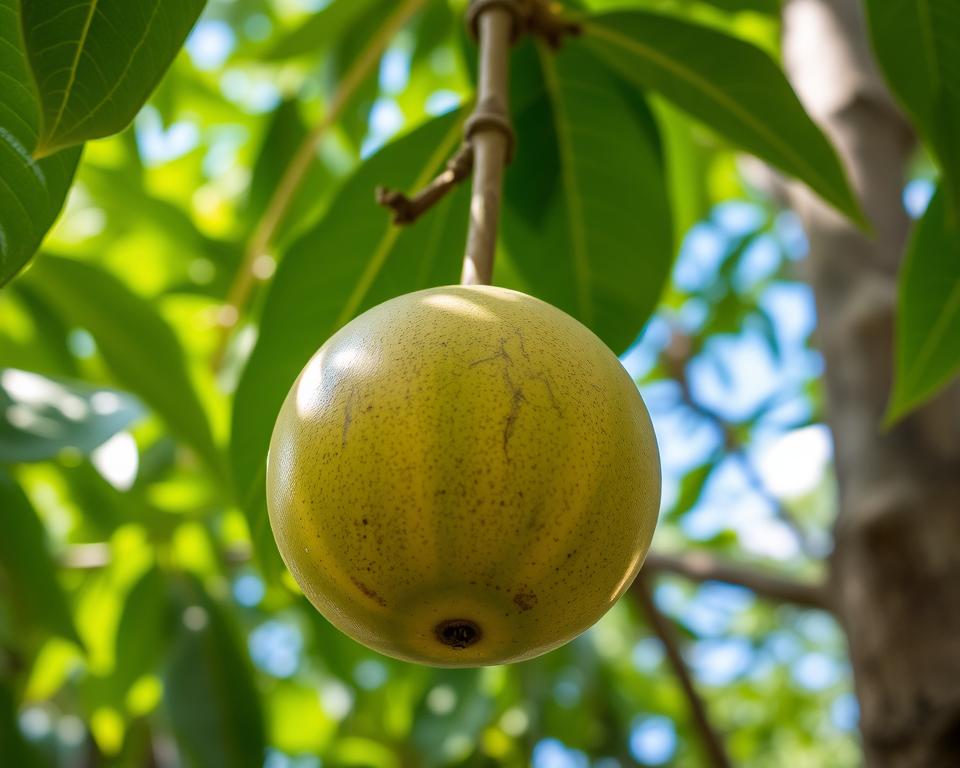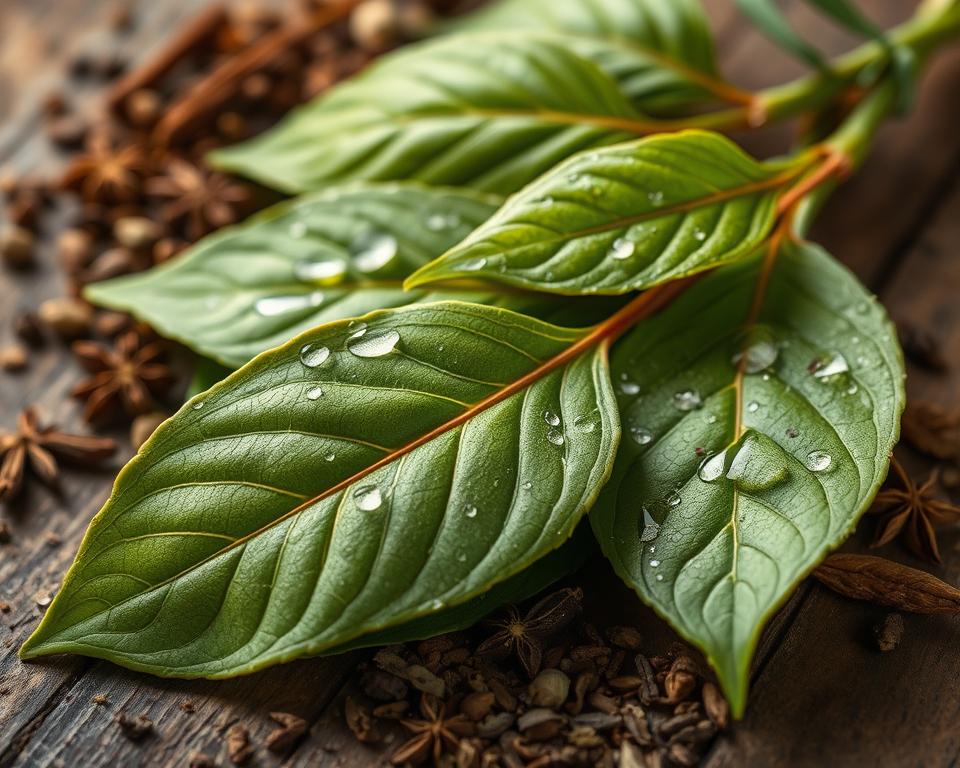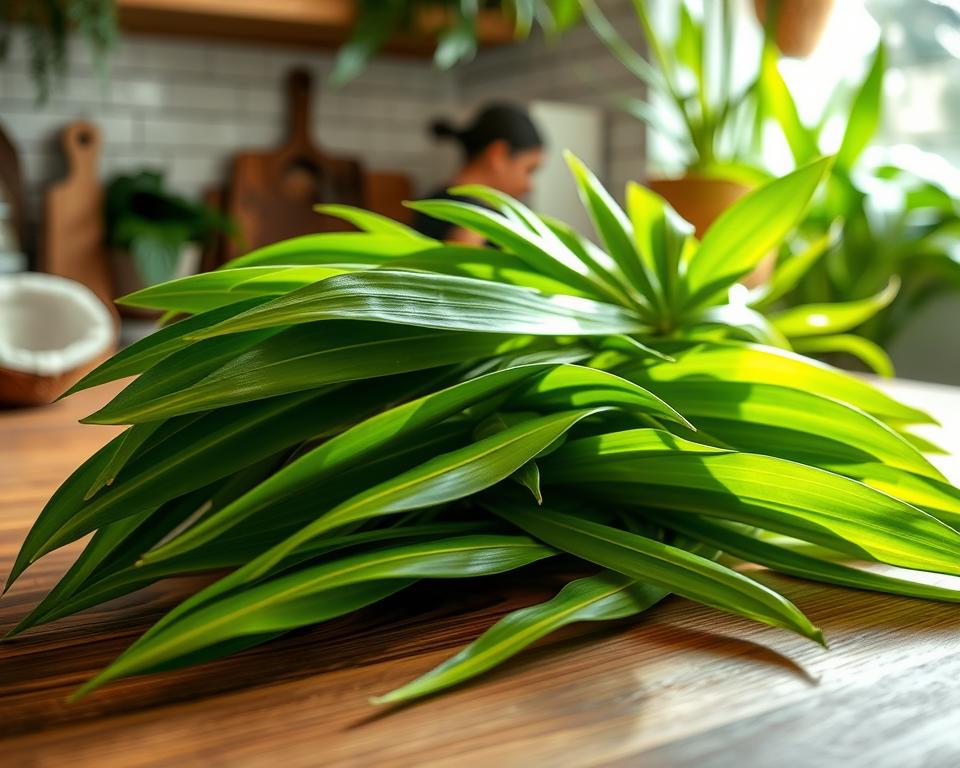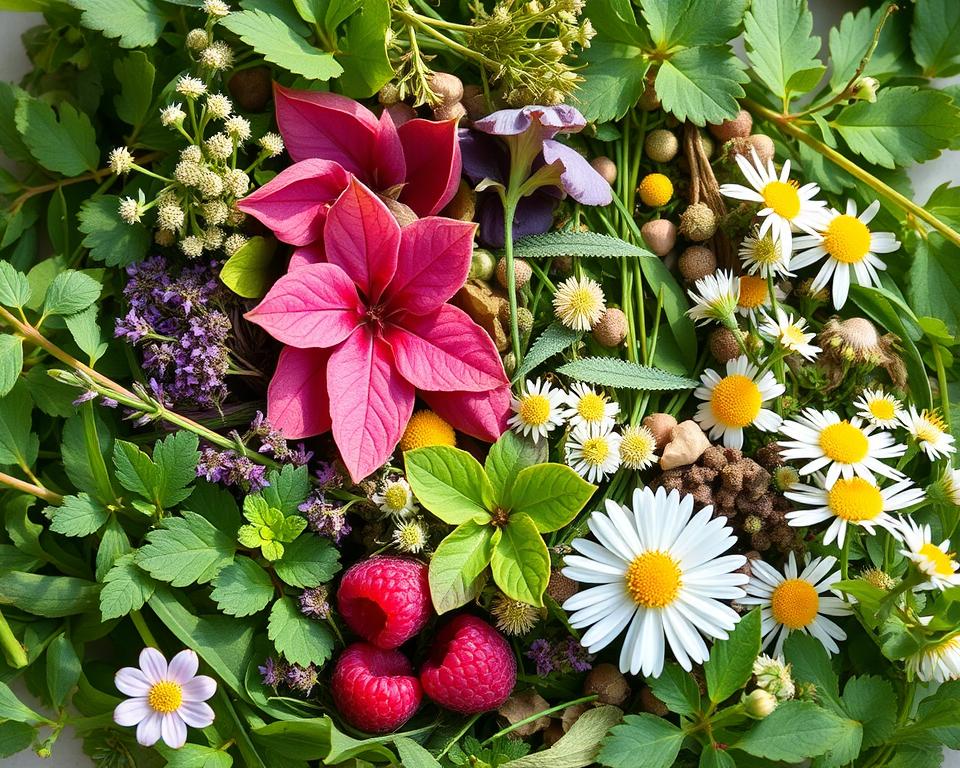Galangal is a key spice in Southeast Asian cooking, especially in Thailand and Indonesia. It has a unique taste that makes it perfect for many dishes. From the famous Tom Yum soup to Thai curries, it adds a special flavor.
But galangal is not just for cooking. It has a long history in traditional medicine. This makes it a fascinating ingredient for both food lovers and health enthusiasts.
Read interesting things at : tosawakan
Key Takeaways
- Galangal is a rhizome spice that plays a crucial role in Southeast Asian cuisines, particularly Thai and Indonesian dishes.
- It has a unique flavor profile that is distinct from its close cousin, ginger.
- Galangal is an essential ingredient in iconic dishes like Tom Yum soup and Thai curries.
- It is also used in traditional herbal remedies, highlighting its versatility.
- Sourcing fresh galangal and identifying its key characteristics is important for optimal culinary use.
Introduction to Galangal
Galangal is a key ingredient in Southeast Asian cooking. It belongs to the ginger family and is known for its unique taste. This rhizome spice has a citrusy and peppery flavor. It makes many dishes more complex and interesting.
In Southeast Asia, galangal has been a main part of the food for a long time. Its special taste is why it’s used in many famous dishes. For example, it’s in the tangy tom yum soup of Thailand and the rich curries of Indonesia.
| Characteristic | Galangal |
|---|---|
| Botanical Name | Alpinia galanga |
| Family | Zingiberaceae (Ginger Family) |
| Origin | Southeast Asia |
| Flavor Profile | Citrusy, peppery, and aromatic |
Galangal is not just for cooking. It’s also being studied for its health benefits. It has anti-inflammatory and antioxidant properties. As more people discover Southeast Asian cuisine, this rhizome spice is getting more popular with cooks at home and in restaurants.
“Galangal is an indispensable ingredient in many Southeast Asian dishes, adding a distinctive and aromatic flavor that is truly unique to the region’s culinary heritage.”
What is Galangal?
Galangal is a special spice that comes from the Alpinia galanga plant. It’s a relative of ginger. Galangal has its own unique taste that makes it stand out in Southeast Asian cooking.
Exploring the Rhizome Spice
The galangal rhizome grows underground in the tropical areas of Southeast Asia. It looks a bit like ginger but has smoother skin and a stronger smell. The inside can be white or light pink, depending on the type.
Distinguishing Galangal from Ginger
Galangal and ginger are both in the Zingiberaceae family but they taste and cook differently. Galangal smells like citrus with hints of pine and camphor. Ginger tastes more spicy and sweet. Galangal is also more fibrous, perfect for slow-cooked dishes.
| Characteristic | Galangal | Ginger |
|---|---|---|
| Appearance | Thick, knotted rhizome with smooth skin | Knobby, irregular-shaped rhizome with fibrous skin |
| Flavor | Intensely aromatic, citrusy, with hints of pine and camphor | Pungent, slightly sweet |
| Texture | More fibrous and less juicy | More juicy and less fibrous |
“Galangal is a unique and essential ingredient in many Southeast Asian dishes, adding a complex, fragrant flavor that sets it apart from other spices.”
Galangal in Thai Cuisine
Galangal is a key ingredient in Thai cooking. It’s used in everything from tom yum soup to Thai curries. This spice adds a unique flavor that makes these dishes special.
Essential Ingredient in Tom Yum Soup
Tom yum soup is a favorite in Thai cuisine. It’s known for its spicy and tangy taste. Galangal adds a citrusy flavor that balances the soup’s other ingredients.
Galangal’s Role in Thai Curries
Galangal isn’t just for tom yum soup. It’s also a must-have in Thai curries. Whether it’s red curry, green curry, or massaman curry, galangal brings depth and a unique aroma.
| Dish | Role of Galangal |
|---|---|
| Tom Yum Soup | Adds a distinctive tart and citrusy note, balancing the overall flavor profile |
| Thai Curries | Provides depth, complexity, and a unique floral aroma that enhances the rich and creamy flavors |
“Galangal is the heart and soul of Thai cuisine, infusing our beloved dishes with its enchanting aroma and flavor.”
– Chef Supatra Vongsvirates, renowned Thai culinary expert
Galangal in Indonesian Cooking
Galangal is a key spice in both Thai and Indonesian cooking. It’s a staple in Indonesian dishes, mixing well with other spices and herbs. This creates the unique tastes of Indonesian food.
Rendang, a slow-cooked beef curry, is famous for its use of galangal. This spice adds a citrusy-earthy flavor and a bit of heat. It makes rendang a favorite dish.
Gulai is another dish where galangal shines. It’s a curry that can be made with chicken, seafood, or veggies. The spice’s strong taste goes great with the curry’s creamy base.
| Dish | Role of Galangal |
|---|---|
| Rendang | Adds citrusy-earthy aroma and subtle heat to the slow-cooked beef curry |
| Gulai | Enhances the rich, creamy curry base with its pungent notes |
Galangal is used in many Indonesian dishes, not just rendang and gulai. It’s in marinades, stews, and sambals, showing its versatility. Galangal is essential in Indonesian cooking, adding a unique flavor.
“Galangal is a must-have ingredient in any authentic Indonesian kitchen, as it adds a distinct and aromatic flavor that is simply irreplaceable.”
Aromatic Flavors of Galangal
Galangal is a key spice in Southeast Asian cooking, known for its unique aroma and flavor. It brings a mix of citrus, pepper, and earthy tastes to dishes. This makes it a key ingredient in many recipes.
Unique Flavor Profile
Galangal tastes like a mix of citrus and pepper with a hint of earth. It’s different from ginger, which is spicier. The special aromas of galangal make it a must-have in Southeast Asian cooking.
Culinary Applications of Galangal
Galangal is great for many dishes, from marinades to curries. It adds a unique taste to seafood, poultry, and vegetables. This spice is a must-have for anyone who loves to cook.
“Galangal’s unique flavor profile is a true delight for the senses, adding an irresistible aromatic dimension to the cuisine of Southeast Asia.”
Galangal is perfect in Tom Yum soup, Thai curry, or as a meat marinade. It’s a key spice that makes dishes more exciting. Its strong aromas and tastes are loved in Southeast Asian cooking.
Health Benefits of Galangal
Galangal is more than just a spice; it’s a health booster. It’s full of antioxidants and anti-inflammatory compounds. These can help keep you healthy when eaten as part of a balanced diet.
Galangal is packed with antioxidants. It has polyphenols that fight off harmful free radicals. This can protect your cells and help your immune system. It might also lower the risk of serious diseases like cancer and heart disease.
Galangal is also known for fighting inflammation. It has compounds like galangin and acetoxychavicol. These can reduce inflammation in the body. This could help with conditions like arthritis, muscle pain, and stomach issues.
| Health Benefit | Potential Mechanism |
|---|---|
| Antioxidant activity | High in polyphenols that scavenge free radicals |
| Anti-inflammatory effects | Inhibits production of pro-inflammatory mediators |
| Digestive support | May help alleviate symptoms of stomach and gut disorders |
| Immune system support | Antioxidant and anti-inflammatory properties may boost immunity |
Galangal offers more than just antioxidant and anti-inflammatory benefits. It might also help with digestion, easing stomach and gut problems. Plus, it could boost your immune system, making it a great addition to a healthy lifestyle.
Remember, always talk to a healthcare professional before adding galangal to your diet or using it for health reasons. Knowing the science behind its benefits lets you make smart choices for your health.
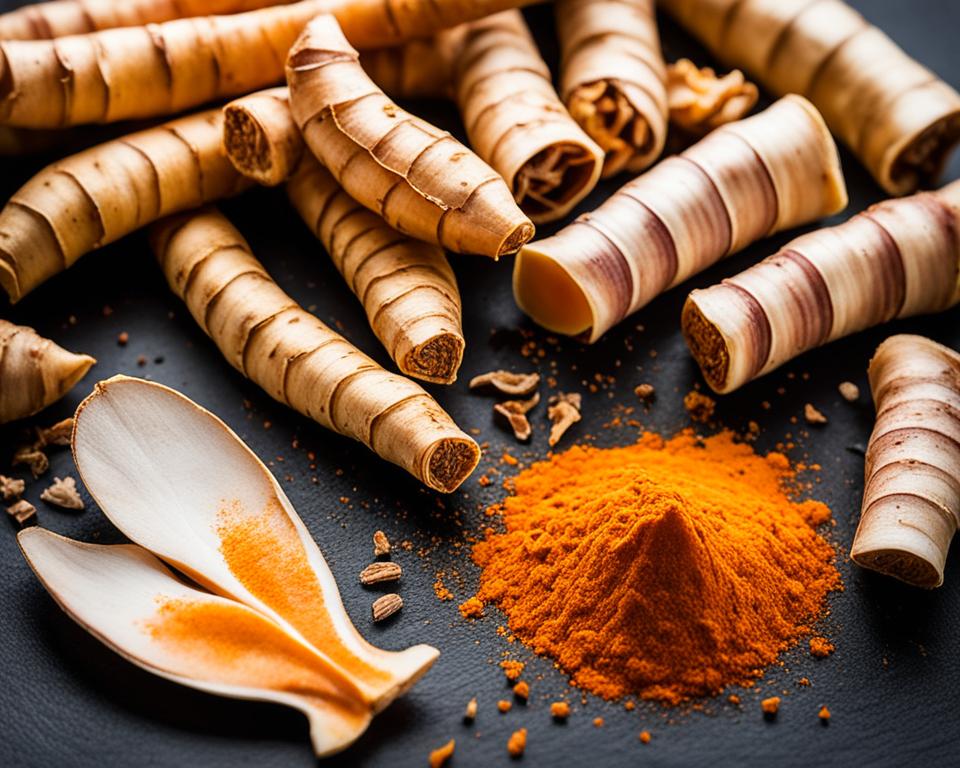
Galangal as a Ginger Substitute
Galangal and ginger are similar but have different tastes. You can use galangal instead of ginger in some recipes. This adds a special flavor while keeping the dish aromatic.
Ginger and galangal come from the same family but are unique. Galangal tastes peppery and pine-like, while ginger is warm and slightly sweet. This makes galangal great for creating new tastes in culinary uses.
When swapping galangal for ginger, think about the dish and the flavor you want. Galangal works well in Thai and Indonesian dishes but might not fit in recipes that need ginger’s unique taste.
Exploring the Possibilities
To use galangal instead of ginger, follow these tips:
- Begin with a small amount of galangal and adjust as needed, as it’s stronger than ginger.
- Combine galangal with flavors like lemongrass, coconut milk, or fish sauce for a balanced taste.
- Try galangal in curries, stir-fries, and soups to give your dishes a unique flavor.
Using galangal as a ginger substitute opens up new culinary uses. It brings depth and complexity to your dishes inspired by Southeast Asia.
Sourcing Fresh Galangal
When looking for galangal, focus on finding fresh, vibrant pieces. This spice is known for its strong smell and taste. It’s a key ingredient in many traditional dishes. Here are some tips to get the best galangal.
Identifying Fresh Galangal
To find fresh galangal, check its color and feel. Choose rhizomes that are bright and firm. Stay away from those that look old or soft. The skin should be smooth, and the shape should be plump.
Storing Galangal for Optimal Freshness
- After buying fresh galangal, keep it fresh by storing it right. Store it in the fridge for weeks.
- Wrap the galangal in a damp paper towel or put it in a sealed bag. This keeps it moist and prevents drying out.
- You can also freeze galangal for longer use. Peel and slice it before freezing in a sealed container or bag.
By following these steps, your galangal will stay fresh and ready to use in your cooking.
“Galangal is an essential spice in Southeast Asian cuisine, adding a complex, citrusy flavor that is simply irreplaceable.”
Alpinia Galanga: The Scientific Name
Galangal is a key spice in Southeast Asian cooking. Its scientific name, Alpinia galanga, tells us a lot about its place in the plant world. It belongs to the Alpinia genus and the Zingiberaceae family, which includes ginger.
This name helps us tell Alpinia galanga apart from other spices like regular ginger (Zingiber officinale). Knowing its scientific name lets us see why it’s so important in Thai, Indonesian, and other cuisines.
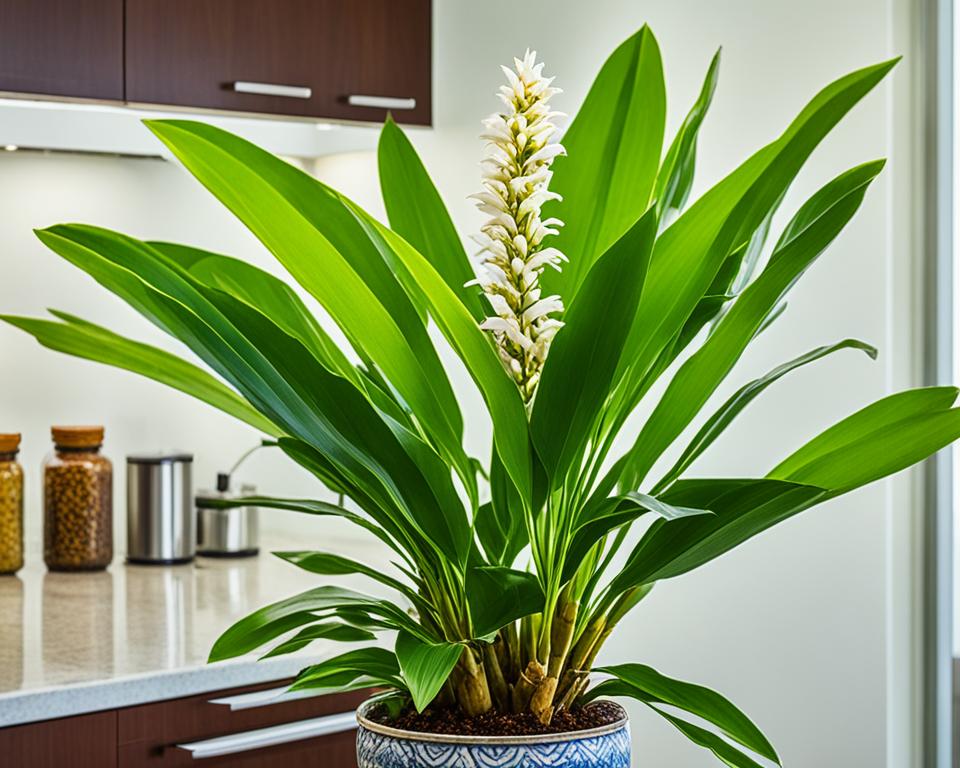
“The scientific name Alpinia galanga is a significant piece of information that helps us understand the botanical relationship between galangal and other members of the ginger family.”
Looking into the Alpinia galanga name also shows its health benefits and uses in cooking. Being in the Alpinia genus, galangal has similar properties and benefits to its plant cousins. This makes it interesting for more study and enjoyment.
Laos Root: Another Name for Galangal
In some parts of Southeast Asia, galangal is called Laos root. This name shows its importance and common use in Laos and nearby countries.
The Laos root, or galangal, is a key ingredient in Southeast Asian cooking for many years. Its strong smell and unique taste make it a must-have in many dishes.
The Versatility of Laos Root
The Laos root is loved for its ability to add depth to many dishes. It’s especially important in Thai and Lao cooking. It gives soups, curries, and stir-fries a special flavor.
- In tom yum soup, the Laos root mixes with lemongrass and other spices to make a hot and sour broth.
- In Thai curries, it blends with coconut milk and chili peppers for a rich taste.
But the Laos root is not just for cooking. It’s also used in traditional medicine in Southeast Asia, showing its many uses.
| Characteristic | Description |
|---|---|
| Appearance | The Laos root, or galangal, looks like ginger with a vibrant yellow color and a firm texture. |
| Flavor | It has a strong smell and tastes a bit like ginger and pine. |
| Culinary Uses | It’s a key ingredient in Thai, Lao, and Indonesian cooking, used in soups, curries, and marinades. |
Whether you call it Laos root or galangal, this rhizome is crucial in Southeast Asia’s tasty and lively foods.
Popular Southeast Asian Dishes Featuring Galangal
Galangal is a key spice in Southeast Asian cooking. It’s used in many famous dishes. From the spicy Thai tom yum soup to the rich Indonesian rendang, it adds a special touch.
In Thai cooking, galangal is vital in making tom yum soup. This soup is hot and sour, with a citrusy taste. Galangal also adds flavor to Thai curries like massaman and red curry.
In Indonesia, galangal is used to make rendang. This is a slow-cooked beef stew with spices, coconut milk, and herbs. It brings out the rich flavors of the dish.
Galangal is not just for soups and curries. It’s also used in marinades, stir-fries, and traditional remedies. Its unique smell and taste are loved in Southeast Asian cooking.
| Dish | Cuisine | Role of Galangal |
|---|---|---|
| Tom Yum Soup | Thai | Essential ingredient, adding citrusy, peppery notes |
| Rendang | Indonesian | Enhances the robust, complex flavors of the slow-cooked beef stew |
| Massaman Curry | Thai | Contributes to the depth and complexity of the curry |
Galangal is a must-have in Southeast Asian cooking. From Bangkok’s streets to Indonesia’s islands, it’s a key ingredient.
“Galangal is the secret ingredient that makes many Southeast Asian dishes so uniquely flavorful and aromatic.”
Galangal in Traditional Herbal Remedies
Galangal is a spice widely used in Southeast Asian cooking. It’s also known for its healing properties in traditional herbal remedies. This spice has been used in alternative medicine for a long time. It’s valued for its ability to heal naturally.
In Thai medicine, galangal is a go-to remedy for many health issues. It’s thought to reduce inflammation, fight off free radicals, and help with digestion. People use it to treat indigestion, nausea, and some breathing problems. It can also be applied to the skin to ease muscle pain.
In Indonesia, galangal is a key ingredient in jamu, a traditional herbal remedy. Jamu is made to improve health and treat various health issues. It’s believed to boost the immune system and improve blood flow.
“Galangal has been a staple in traditional Southeast Asian medicine for centuries, valued for its potential therapeutic benefits and versatility as a natural remedy.”
Galangal is not just used in Southeast Asia. It’s also recognized for its health benefits in other parts of the world. In Ayurvedic medicine, it helps with digestion and supports the lungs.
As scientists study galangal more, its long history in traditional medicine shows its value. It’s a versatile spice with a lot to offer in natural healing.
Growing Galangal at Home
If you love gardening and exotic flavors, growing galangal at home is a great idea. Known as the “Thai ginger,” this vibrant rhizome can flourish with the right care. It lets gardeners enjoy the unique taste of galangal right from their own gardens.
To grow galangal well, you need the perfect environment. It loves warm, humid places, just like its home in Southeast Asia. Gardeners in USDA hardiness zones 8-11 might find it easiest to grow galangal outside. Those in cooler areas can grow it in containers on sunny patios or balconies.
- Choose a well-draining, fertile soil rich in organic matter.
- Plant galangal rhizomes in partial shade, with at least 6 hours of direct sunlight per day.
- Water the plants regularly, keeping the soil moist but not waterlogged.
- Mulch around the plants to retain moisture and suppress weeds.
- Harvest the galangal rhizomes when the plant is around 8-12 months old, carefully digging around the base of the plant.
With patience and the right care, you can enjoy the unique taste and smell of fresh galangal in your cooking. Growing galangal at home adds a new level of fun to your gardening hobby. It’s a way to bring a bit of Thailand into your kitchen.
Conclusion
Galangal is a key spice in Southeast Asian cooking. It brings a unique taste with its mix of citrus, ginger, and floral notes. This makes it a must-have in Thai and Indonesian dishes.
It’s famous for its role in Tom Yum Soup and Thai curries. Galangal is also known for its health benefits, being full of antioxidants and anti-inflammatory compounds. This spice is loved by food lovers around the globe, whether it’s fresh, dried, or in other forms.
As we end our journey with galangal, it’s clear this spice is more than just a flavor booster. It’s a symbol of Southeast Asia’s rich culture and culinary traditions. It opens a door to the region’s diverse and vibrant flavors.





